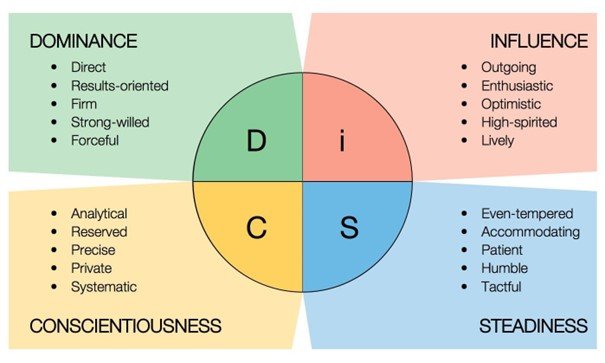DISC MODEL
The last model of team building we are going to introduce to you is the DISC model. This model focuses on the personalities of your team members, and it stands for Dominance, Influence, Steadiness, and Conscientiousness. The aim of this model is to foster better communication, boost teamwork and create an environment where everyone in your team feels valued and understood.

DISC model explained
The DISC model sees your team as a puzzle, where each piece is a different personality. In order to see the complete picture, you will need to understand how those pieces fit together. Here you can find a link to a free DISC personality test: https://discpersonalitytesting.com/free-disc-test/ In the next part of this chapter, we are going to explain all of the major personality styles (dominance, influence, steadiness, conscientiousness):
- Dominance (D): people with this personality style are assertive, result-oriented, and love to take charge. They are comfortable in fast-paced environments and they are great at making quick decisions.
- Influence (I): people with this personality style are social butterflies – they are usually enthusiastic, persuasive and great at communication. They are amazing in situations where interacting and collaborating with other people are the key. People with this personality type are also great at motivating others.
- Steadiness (S): people with this personality type are calm and dependable. They prefer stability, but they are consistent and excellent at supporting the team through their reliability.
- Conscientiousness (C): people with this personality type are analytical, precise and value accuracy above everything else. They are great at solving problems and making sure that the team doesn’t overlook important details.
According to the DISC model, recognizing the personalities in your team is crucial, because it is all about understanding and appreciating unique strengths each person brings to the table.

Source: https://imsts.com/what-is-disc
Leading the team
In order to be able to lead your team effectively, you need to understand that communication is the key – and different personalities prefer different communication styles. For example, Dominance types prefer directness and brevity, while Influence types prefer a more friendly and collaborative approach. You should adjust your communication style to match what is required by your team members, because that will lead to better understanding and fewer conflicts. The same is true for motivation – different personality types are motivated by different things – and recognizing this motivation will allow you to lead your team in a way that resonates with each team member.
It is important to embrace the diversity within your team, because teams with a mix of DISC personality types can be very dynamic. For example, Dominance personality type’s drive is progress, Influence personality types try to create a positive atmosphere, Steadiness types provide reliable support, and Conscientiousness types ensure accuracy and quality. If you are to be a team leader, your role would be to find balance between those traits, and ensure that each personality type is valued and utilized effectively. Here are some recommendations on which types of team building activities to use with each DISC type:
- Dominance – activities like debates, problem-solving contests, sports events
- Influence – activities that allow them to express their creativity and social skills; such as brainstorming sessions
- Steadiness – group projects where they can contribute consistently and supportively; for example, a team volunteer day or a collaborative puzzle game
- Conscientiousness – activities that require attention to detail and precision; for example, team-based trivia quizzes and planning complex project timelines
If you decide to do some of those team building activities, don’t limit them only to specific personality types – encourage everyone to participate in each. This will help team members understand and appreciate different personalities, and promote a well-rounded skill set across your team.
Of course, after you use DISC team building activities, you will want to measure their impact. How can you do that? Well, you can, for example, do regular feedback sessions during which team members can discuss their experiences with team building activities they were participating in. You could also observe changes in team interactions and dynamics – trying to note if team members are communicating more effectively or is there a noticeable improvement in how they resolve conflicts.

DICLAIMER
Funded by the European Union. Views and opinions expressed are however those of the author(s) only and do not necessarily reflect those of the European Union or the ANPCDEFP. Neither the European Union nor the ANPCDEFP can be held responsible for them.